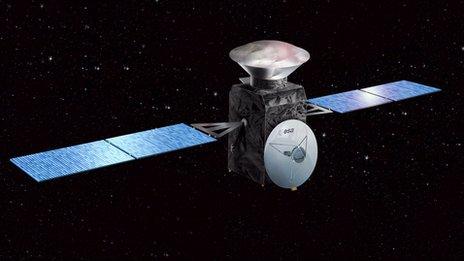Esa-Nasa Mars missions' race against clock
- Published
- comments

The orbits of Mars and Earth mean there is only one launch window every 26 months or so
Europe and America are now in a race against time to rescue their plans for joint missions to Mars.
The space agencies (Esa and Nasa) want to send an orbiting satellite to the Red Planet in 2016, followed by a large rover two years later.
But funding woes on both sides of the Atlantic have put the ventures in doubt, certainly in their present form.
Unless solutions are found soon, there is a grave danger the 2016 and 2018 launch opportunities will be missed.
Officials are now looking at the possibility of making the ExoMars missions - as they are known in Europe - smaller in scale to reduce cost, or gaining additional funds by asking the Russians to enlist in the programme.
"We are now trying for certain recovery actions so that we can still do the missions," said Alvaro Gimenez, the director of science at Esa.
"We are determined to do these missions; Esa and Nasa want to do these missions, but we have to work within the budgetary constraints on both sides. We are working into it, but against the clock," he told BBC News.
No promises
European industry says it must start full-scale work very soon on the 2016 Trace Gas Orbiter or it cannot guarantee to have the spacecraft ready for launch in 2016.
With favourable Mars launch windows only occurring roughly every 26 months, a no-show at the launch pad from the orbiter would immediately put a big question mark against the rover mission, not least because the satellite is supposed to act as the surface vehicle's relay to get pictures and other data back to Earth.
Europe does not have all the money it needs to do the missions, but anxiety has been heightened in recent days following the inability once again of Nasa to make a full commitment to the ventures.
Esa is waiting for the Americans to provide certain assurances that they will be in a position in 2018 to provide a rocket, an interplanetary cruise stage to take the rover to Mars, and a landing system to put it on the surface.
Those assurances were expected back in June, and did not materialise.
And at the latest meeting of Esa member states in Paris last week, the delegations were informed that Nasa, because of ongoing budget uncertainty in Washington, was still not in a position to give those promises.
Without them, however, Esa will not issue the full industrial contract to proceed with the construction of the orbiter, fearing it could spend hundreds of millions of euros on the satellite but never see its main objective - the rover - land on Mars.
Industry is having to operate under authorisations that permit only the minimum works necessary to keep the 2016 satellite on track, but this arrangement cannot continue for many more weeks.
'Frustratingly close'
Officials are now looking at two options to try to break the impasse.
One would see Esa and Nasa seek additional finance outside their partnership.
The obvious candidates are the Russians, who might be persuaded to provide one of the two rockets needed for the Exomars missions if their scientists are allowed to participate in the projects. The second option is to de-scope the missions to make them less expensive. In the extreme scenarios, the possibilities here might include foregoing either the satellite mission or indeed the rover.
More likely is a de-scoping option that drops the plan for a landing demonstrator on the 2016 mission.
Europe is keen to have a go at touching down on Mars and the current baseline design for the orbiter mission calls for a 600kg entry, descent and landing module.
This module is not an integral part of 2016's science objectives but it would give Europe important expertise for the future.
"Any de-scope we may have to face would be a loss of great importance for Europe and is something we are not ready to accept," said Dr Gimenez.
"That is why we are fighting to get back to the baseline. ExoMars is a challenging, difficult but tremendously important project if we ever want to have a robotic exploration programme in our neighbourhood in the Solar System. In ExoMars, we have all the technologies we need, so to lose any components is not good."
The irony is that negotiations between European and American engineers over who should do what on the 2018 rover is going very well.
Both sides drew up lists of non-negotiable and high-priority roles, and Europe has succeeded in winning most of what it wanted. Important roles for Europe include assembling the rover on its side of the Atlantic and using a British-designed autonomous navigation system when the vehicle is on Mars.
"The frustration is that we are very close to getting what we want, but we have to resolve this budget situation and soon," said Dr David Parker, director of science, technology and exploration at the UK Space Agency.
Asked to comment on the situation, the US space agency told BBC News: "Nasa and Esa technical teams have been conducting a joint assessment of alternative Mars exploration scenarios over the past several weeks to determine how best to meet our jointly agreed programme objectives within budgetary constraints on both sides.
"This joint Nasa-Esa technical assessment is continuing. The agency will continue to discuss and assess a plan with Esa that will not only be cost-effective, but ensure key science objectives are met."
- Published5 September 2011
- Published30 June 2011

- Published7 April 2011
- Published8 March 2011